Media Representations of Women's and Men's Bodies: Gender and Society
VerifiedAdded on 2022/12/28
|11
|3462
|240
Essay
AI Summary
This essay delves into the multifaceted representations of women's and men's bodies in media, examining how these portrayals shape and reinforce gender stereotypes. It explores the historical evolution of these representations, highlighting the shift from the 1980s to contemporary scenarios. The essay analyzes the influence of media on the social construction of gender and body image, discussing how media outlets often depict men as strong and aggressive while portraying women as beautiful, passive, and primarily focused on appearance. It also examines the embodied experiences of health and illness for both genders, the representation of bodies in art and media, and the role of social control in shaping perceptions. The essay highlights the impact of media on body image, the unrealistic standards it promotes, and the resulting pressures and potential mental health consequences for individuals. The essay underscores the importance of understanding these representations and their impact on societal views of gender and body image.
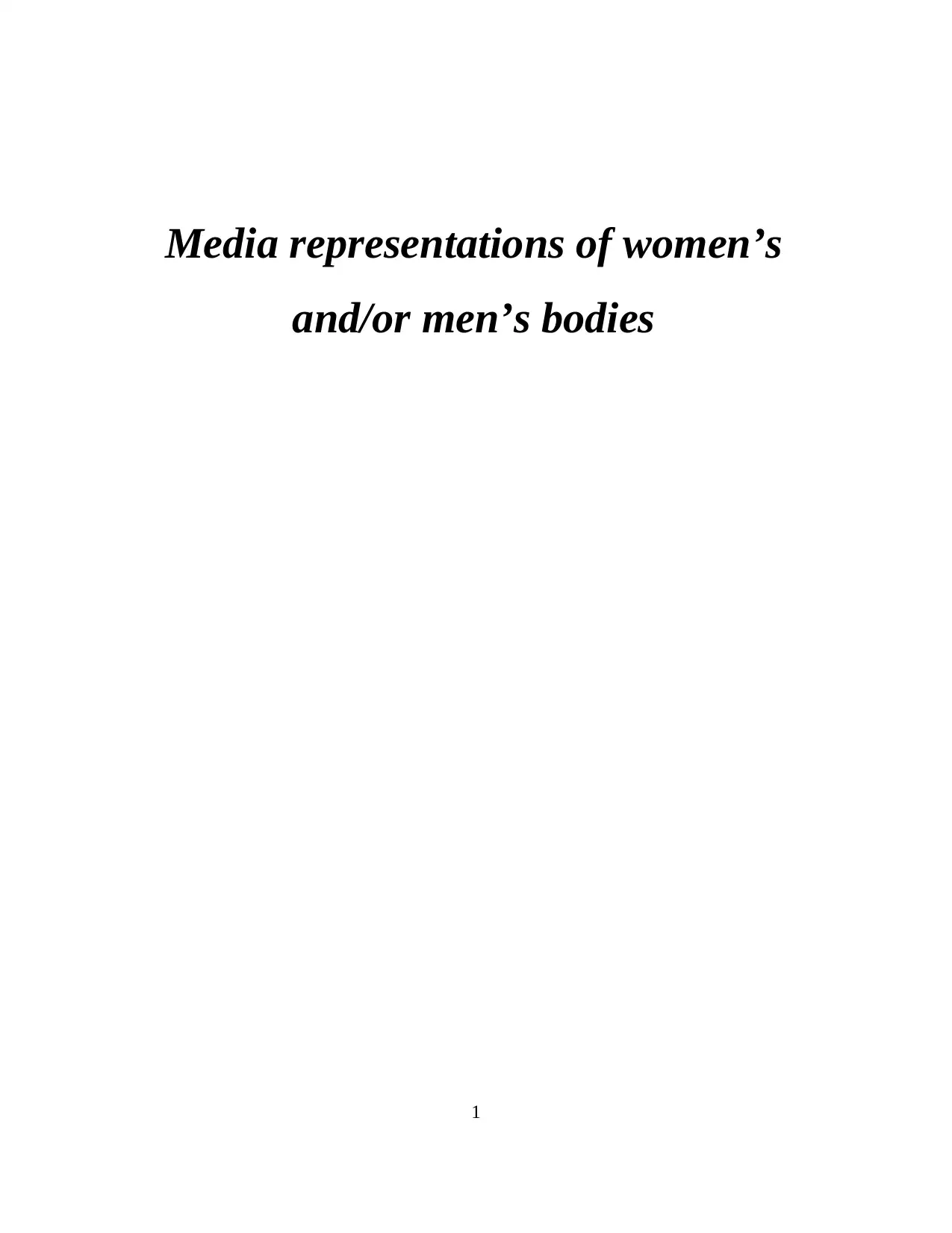
Media representations of women’s
and/or men’s bodies
1
and/or men’s bodies
1
Paraphrase This Document
Need a fresh take? Get an instant paraphrase of this document with our AI Paraphraser
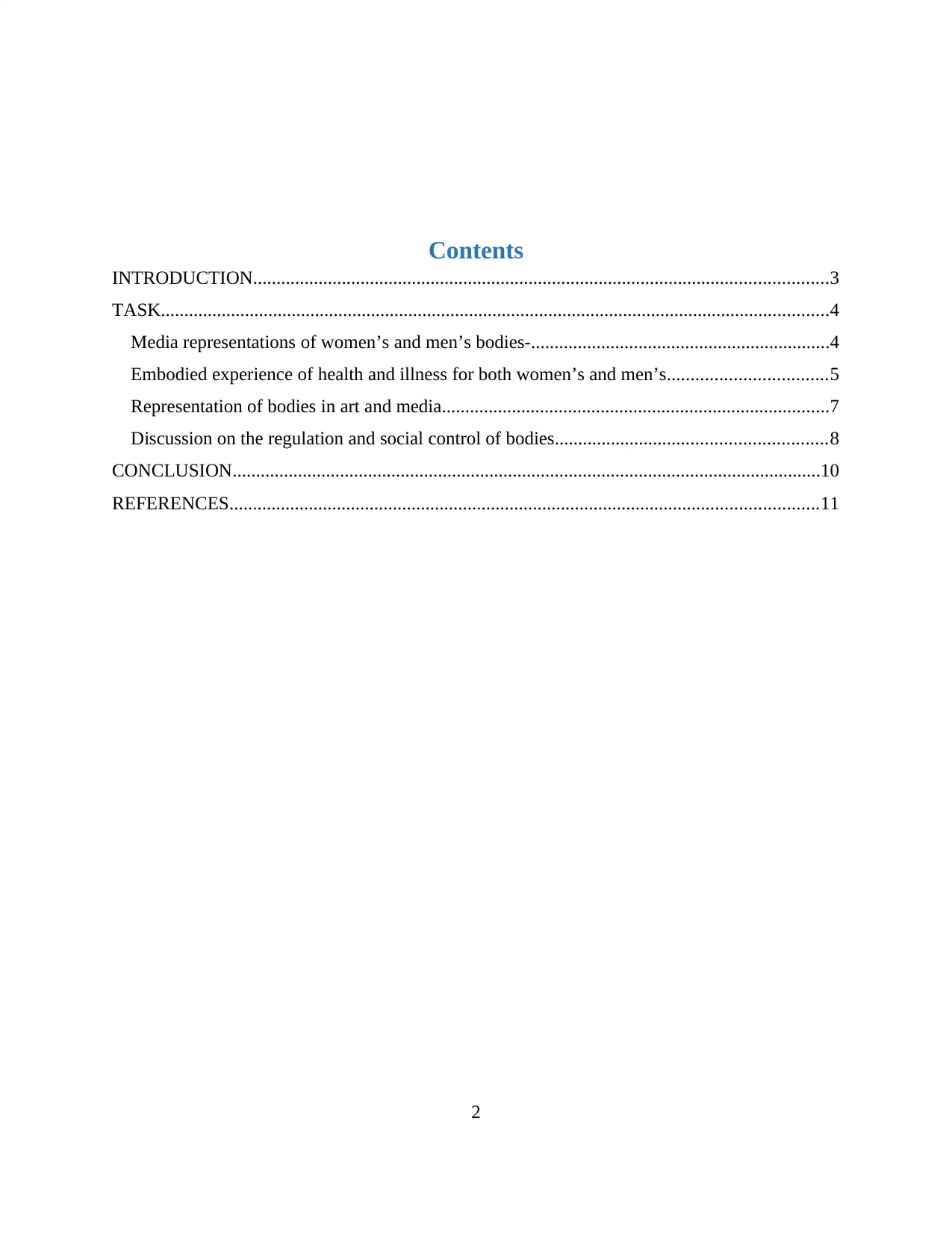
Contents
INTRODUCTION...........................................................................................................................3
TASK...............................................................................................................................................4
Media representations of women’s and men’s bodies-................................................................4
Embodied experience of health and illness for both women’s and men’s..................................5
Representation of bodies in art and media...................................................................................7
Discussion on the regulation and social control of bodies..........................................................8
CONCLUSION..............................................................................................................................10
REFERENCES..............................................................................................................................11
2
INTRODUCTION...........................................................................................................................3
TASK...............................................................................................................................................4
Media representations of women’s and men’s bodies-................................................................4
Embodied experience of health and illness for both women’s and men’s..................................5
Representation of bodies in art and media...................................................................................7
Discussion on the regulation and social control of bodies..........................................................8
CONCLUSION..............................................................................................................................10
REFERENCES..............................................................................................................................11
2
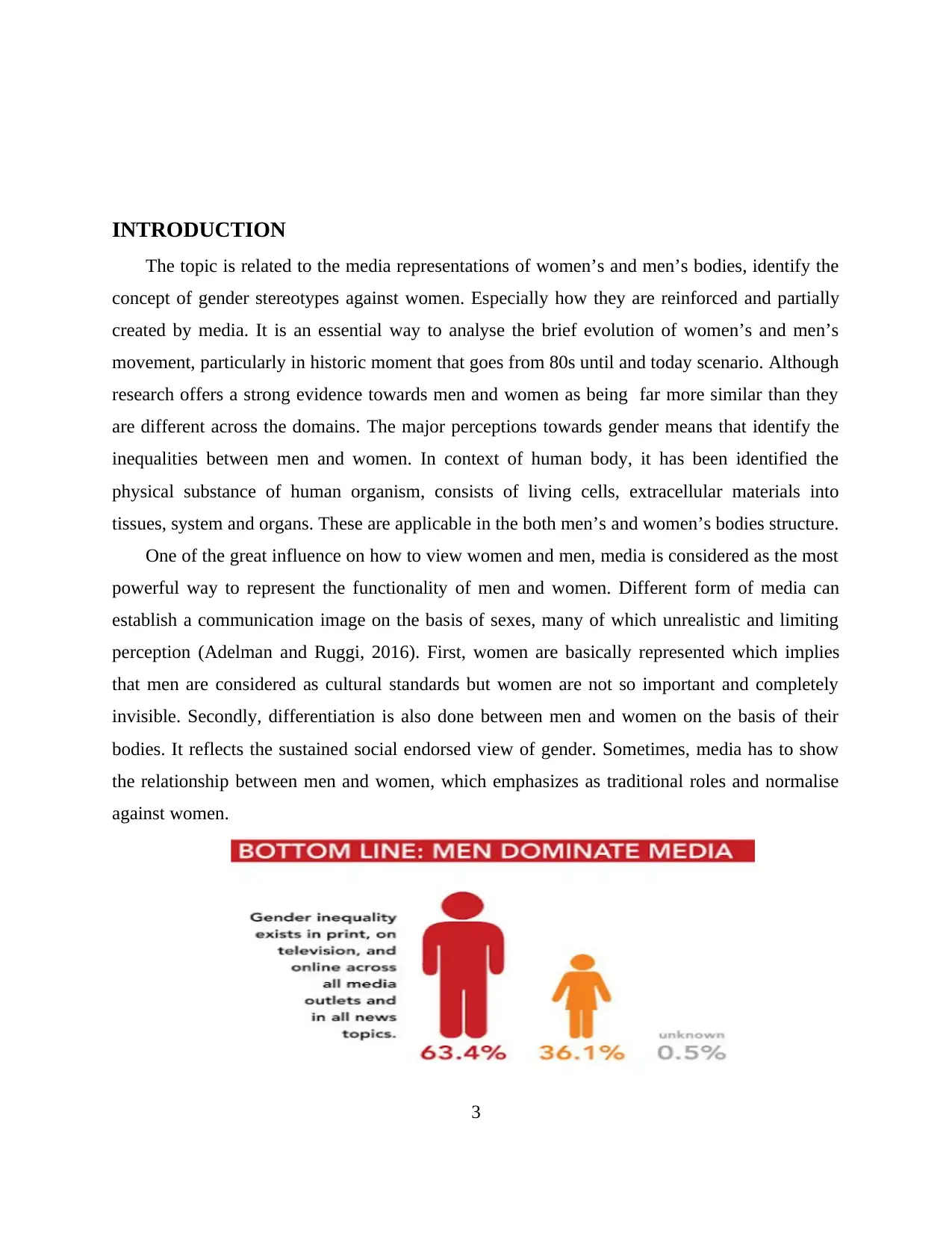
INTRODUCTION
The topic is related to the media representations of women’s and men’s bodies, identify the
concept of gender stereotypes against women. Especially how they are reinforced and partially
created by media. It is an essential way to analyse the brief evolution of women’s and men’s
movement, particularly in historic moment that goes from 80s until and today scenario. Although
research offers a strong evidence towards men and women as being far more similar than they
are different across the domains. The major perceptions towards gender means that identify the
inequalities between men and women. In context of human body, it has been identified the
physical substance of human organism, consists of living cells, extracellular materials into
tissues, system and organs. These are applicable in the both men’s and women’s bodies structure.
One of the great influence on how to view women and men, media is considered as the most
powerful way to represent the functionality of men and women. Different form of media can
establish a communication image on the basis of sexes, many of which unrealistic and limiting
perception (Adelman and Ruggi, 2016). First, women are basically represented which implies
that men are considered as cultural standards but women are not so important and completely
invisible. Secondly, differentiation is also done between men and women on the basis of their
bodies. It reflects the sustained social endorsed view of gender. Sometimes, media has to show
the relationship between men and women, which emphasizes as traditional roles and normalise
against women.
3
The topic is related to the media representations of women’s and men’s bodies, identify the
concept of gender stereotypes against women. Especially how they are reinforced and partially
created by media. It is an essential way to analyse the brief evolution of women’s and men’s
movement, particularly in historic moment that goes from 80s until and today scenario. Although
research offers a strong evidence towards men and women as being far more similar than they
are different across the domains. The major perceptions towards gender means that identify the
inequalities between men and women. In context of human body, it has been identified the
physical substance of human organism, consists of living cells, extracellular materials into
tissues, system and organs. These are applicable in the both men’s and women’s bodies structure.
One of the great influence on how to view women and men, media is considered as the most
powerful way to represent the functionality of men and women. Different form of media can
establish a communication image on the basis of sexes, many of which unrealistic and limiting
perception (Adelman and Ruggi, 2016). First, women are basically represented which implies
that men are considered as cultural standards but women are not so important and completely
invisible. Secondly, differentiation is also done between men and women on the basis of their
bodies. It reflects the sustained social endorsed view of gender. Sometimes, media has to show
the relationship between men and women, which emphasizes as traditional roles and normalise
against women.
3
⊘ This is a preview!⊘
Do you want full access?
Subscribe today to unlock all pages.

Trusted by 1+ million students worldwide
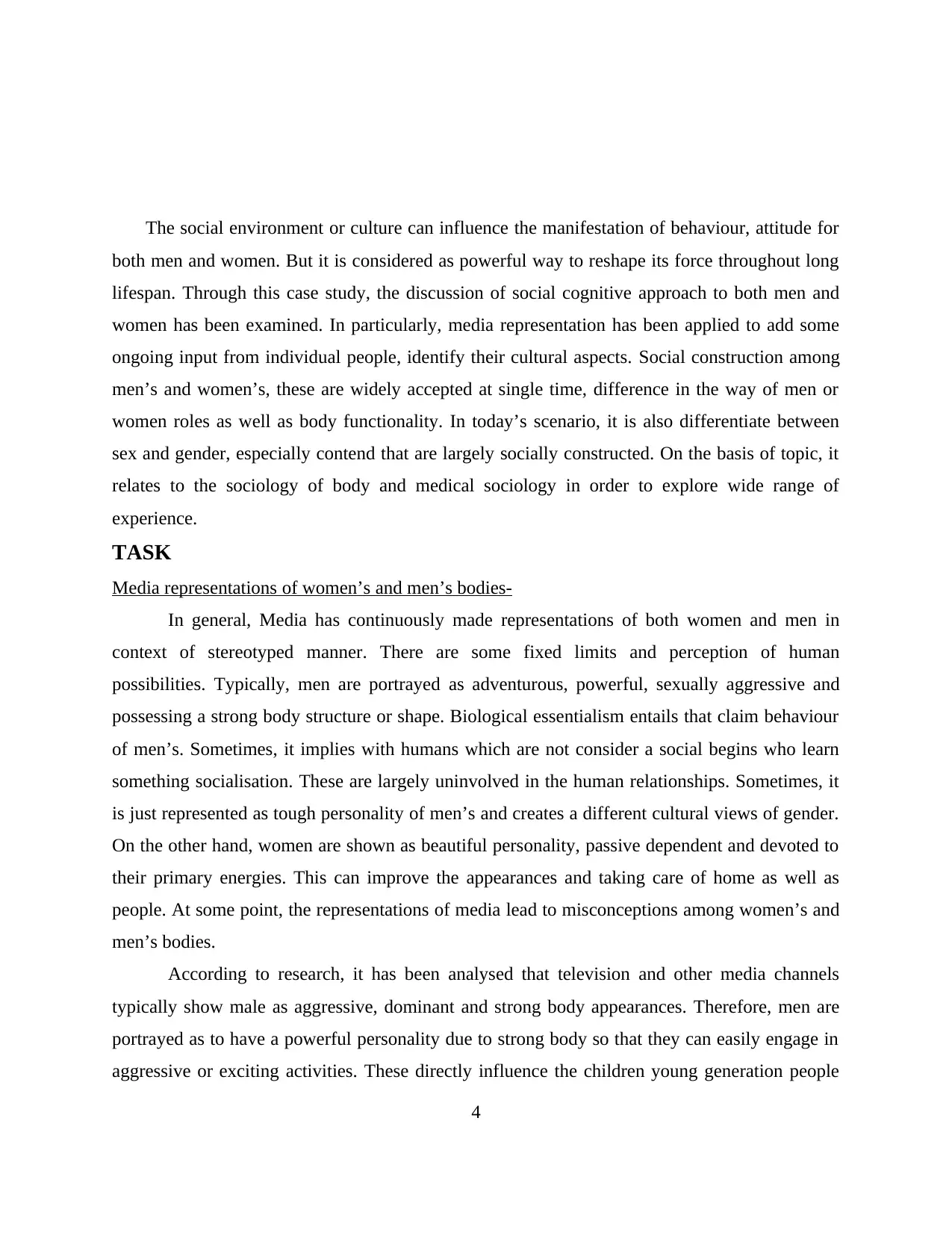
The social environment or culture can influence the manifestation of behaviour, attitude for
both men and women. But it is considered as powerful way to reshape its force throughout long
lifespan. Through this case study, the discussion of social cognitive approach to both men and
women has been examined. In particularly, media representation has been applied to add some
ongoing input from individual people, identify their cultural aspects. Social construction among
men’s and women’s, these are widely accepted at single time, difference in the way of men or
women roles as well as body functionality. In today’s scenario, it is also differentiate between
sex and gender, especially contend that are largely socially constructed. On the basis of topic, it
relates to the sociology of body and medical sociology in order to explore wide range of
experience.
TASK
Media representations of women’s and men’s bodies-
In general, Media has continuously made representations of both women and men in
context of stereotyped manner. There are some fixed limits and perception of human
possibilities. Typically, men are portrayed as adventurous, powerful, sexually aggressive and
possessing a strong body structure or shape. Biological essentialism entails that claim behaviour
of men’s. Sometimes, it implies with humans which are not consider a social begins who learn
something socialisation. These are largely uninvolved in the human relationships. Sometimes, it
is just represented as tough personality of men’s and creates a different cultural views of gender.
On the other hand, women are shown as beautiful personality, passive dependent and devoted to
their primary energies. This can improve the appearances and taking care of home as well as
people. At some point, the representations of media lead to misconceptions among women’s and
men’s bodies.
According to research, it has been analysed that television and other media channels
typically show male as aggressive, dominant and strong body appearances. Therefore, men are
portrayed as to have a powerful personality due to strong body so that they can easily engage in
aggressive or exciting activities. These directly influence the children young generation people
4
both men and women. But it is considered as powerful way to reshape its force throughout long
lifespan. Through this case study, the discussion of social cognitive approach to both men and
women has been examined. In particularly, media representation has been applied to add some
ongoing input from individual people, identify their cultural aspects. Social construction among
men’s and women’s, these are widely accepted at single time, difference in the way of men or
women roles as well as body functionality. In today’s scenario, it is also differentiate between
sex and gender, especially contend that are largely socially constructed. On the basis of topic, it
relates to the sociology of body and medical sociology in order to explore wide range of
experience.
TASK
Media representations of women’s and men’s bodies-
In general, Media has continuously made representations of both women and men in
context of stereotyped manner. There are some fixed limits and perception of human
possibilities. Typically, men are portrayed as adventurous, powerful, sexually aggressive and
possessing a strong body structure or shape. Biological essentialism entails that claim behaviour
of men’s. Sometimes, it implies with humans which are not consider a social begins who learn
something socialisation. These are largely uninvolved in the human relationships. Sometimes, it
is just represented as tough personality of men’s and creates a different cultural views of gender.
On the other hand, women are shown as beautiful personality, passive dependent and devoted to
their primary energies. This can improve the appearances and taking care of home as well as
people. At some point, the representations of media lead to misconceptions among women’s and
men’s bodies.
According to research, it has been analysed that television and other media channels
typically show male as aggressive, dominant and strong body appearances. Therefore, men are
portrayed as to have a powerful personality due to strong body so that they can easily engage in
aggressive or exciting activities. These directly influence the children young generation people
4
Paraphrase This Document
Need a fresh take? Get an instant paraphrase of this document with our AI Paraphraser
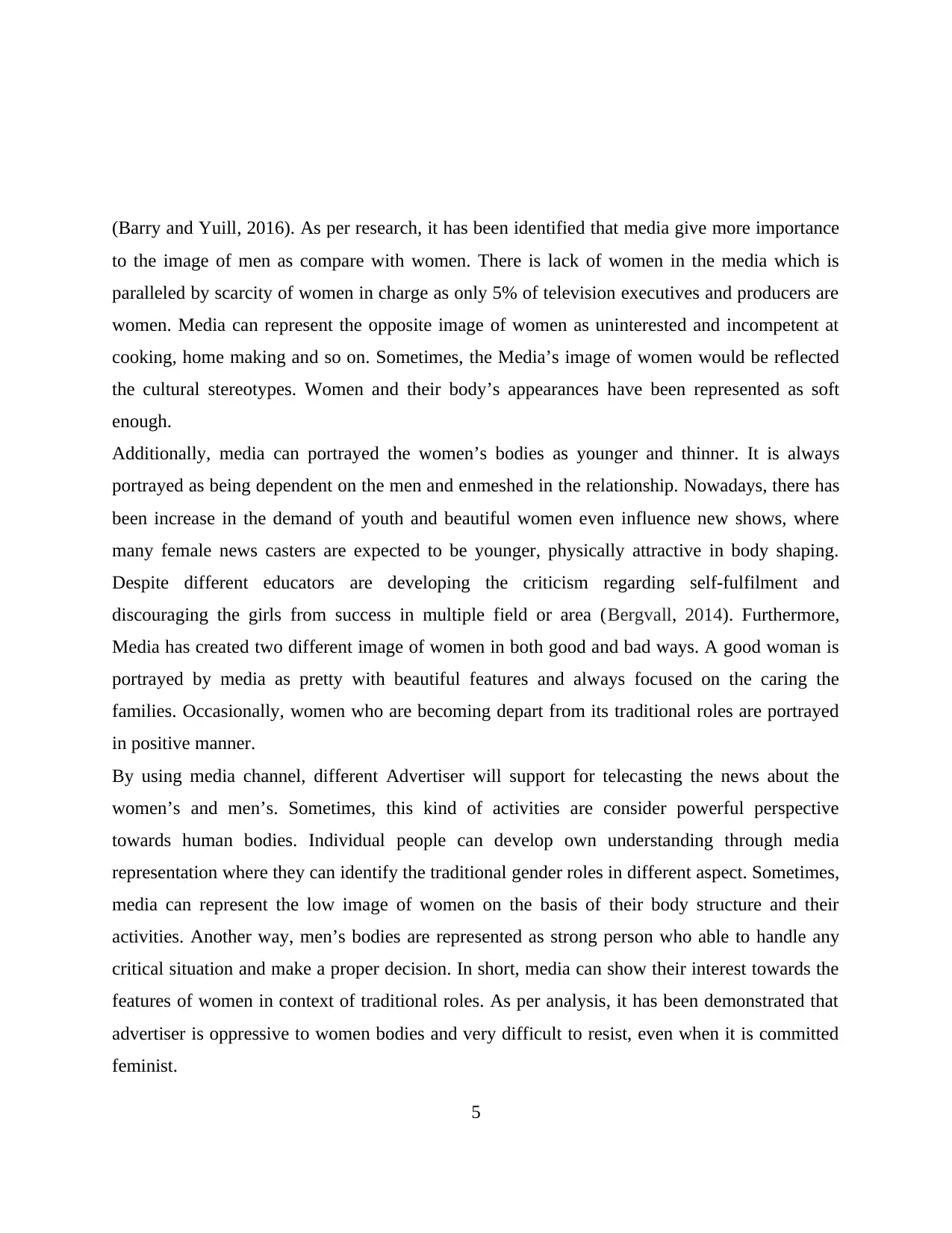
(Barry and Yuill, 2016). As per research, it has been identified that media give more importance
to the image of men as compare with women. There is lack of women in the media which is
paralleled by scarcity of women in charge as only 5% of television executives and producers are
women. Media can represent the opposite image of women as uninterested and incompetent at
cooking, home making and so on. Sometimes, the Media’s image of women would be reflected
the cultural stereotypes. Women and their body’s appearances have been represented as soft
enough.
Additionally, media can portrayed the women’s bodies as younger and thinner. It is always
portrayed as being dependent on the men and enmeshed in the relationship. Nowadays, there has
been increase in the demand of youth and beautiful women even influence new shows, where
many female news casters are expected to be younger, physically attractive in body shaping.
Despite different educators are developing the criticism regarding self-fulfilment and
discouraging the girls from success in multiple field or area (Bergvall, 2014). Furthermore,
Media has created two different image of women in both good and bad ways. A good woman is
portrayed by media as pretty with beautiful features and always focused on the caring the
families. Occasionally, women who are becoming depart from its traditional roles are portrayed
in positive manner.
By using media channel, different Advertiser will support for telecasting the news about the
women’s and men’s. Sometimes, this kind of activities are consider powerful perspective
towards human bodies. Individual people can develop own understanding through media
representation where they can identify the traditional gender roles in different aspect. Sometimes,
media can represent the low image of women on the basis of their body structure and their
activities. Another way, men’s bodies are represented as strong person who able to handle any
critical situation and make a proper decision. In short, media can show their interest towards the
features of women in context of traditional roles. As per analysis, it has been demonstrated that
advertiser is oppressive to women bodies and very difficult to resist, even when it is committed
feminist.
5
to the image of men as compare with women. There is lack of women in the media which is
paralleled by scarcity of women in charge as only 5% of television executives and producers are
women. Media can represent the opposite image of women as uninterested and incompetent at
cooking, home making and so on. Sometimes, the Media’s image of women would be reflected
the cultural stereotypes. Women and their body’s appearances have been represented as soft
enough.
Additionally, media can portrayed the women’s bodies as younger and thinner. It is always
portrayed as being dependent on the men and enmeshed in the relationship. Nowadays, there has
been increase in the demand of youth and beautiful women even influence new shows, where
many female news casters are expected to be younger, physically attractive in body shaping.
Despite different educators are developing the criticism regarding self-fulfilment and
discouraging the girls from success in multiple field or area (Bergvall, 2014). Furthermore,
Media has created two different image of women in both good and bad ways. A good woman is
portrayed by media as pretty with beautiful features and always focused on the caring the
families. Occasionally, women who are becoming depart from its traditional roles are portrayed
in positive manner.
By using media channel, different Advertiser will support for telecasting the news about the
women’s and men’s. Sometimes, this kind of activities are consider powerful perspective
towards human bodies. Individual people can develop own understanding through media
representation where they can identify the traditional gender roles in different aspect. Sometimes,
media can represent the low image of women on the basis of their body structure and their
activities. Another way, men’s bodies are represented as strong person who able to handle any
critical situation and make a proper decision. In short, media can show their interest towards the
features of women in context of traditional roles. As per analysis, it has been demonstrated that
advertiser is oppressive to women bodies and very difficult to resist, even when it is committed
feminist.
5
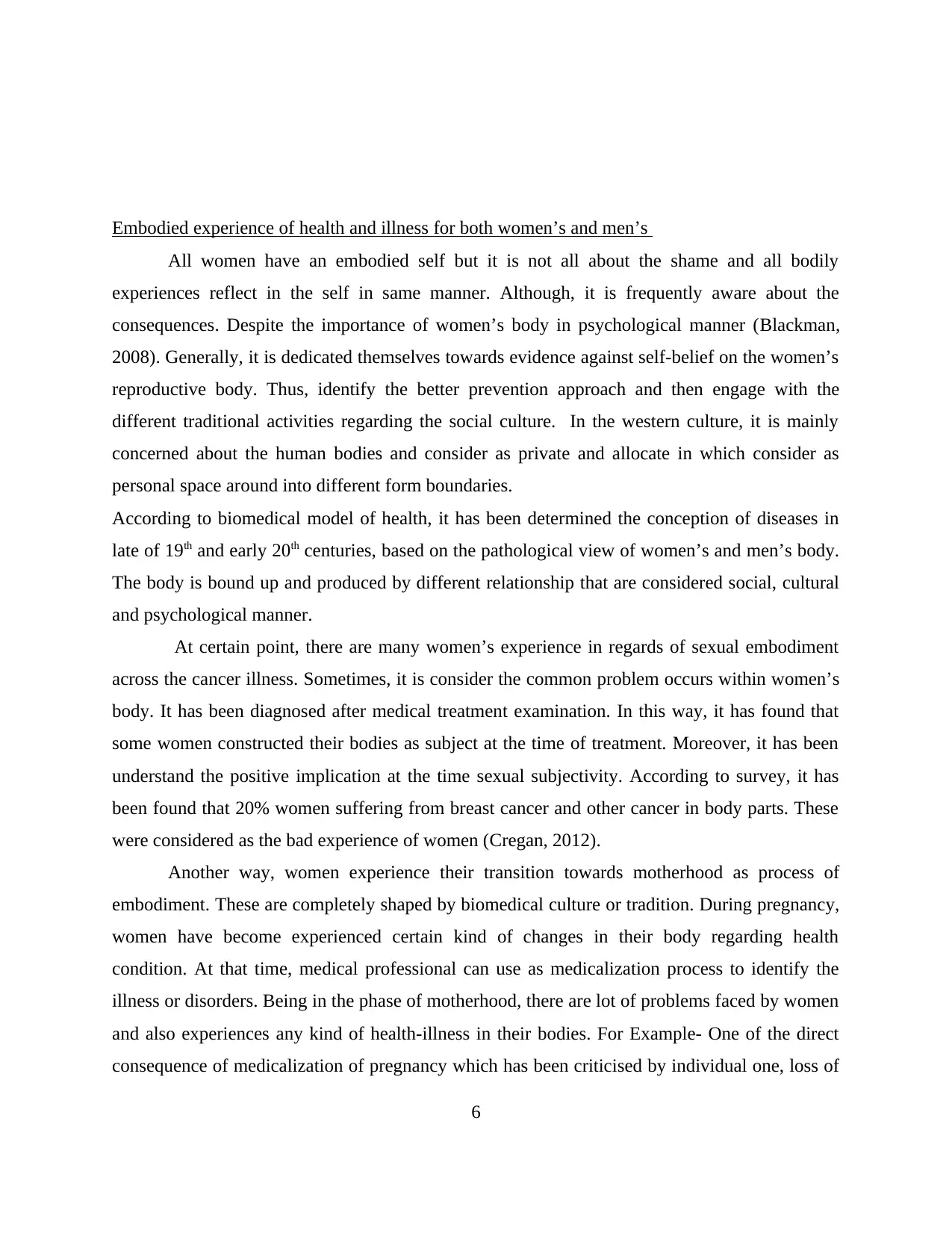
Embodied experience of health and illness for both women’s and men’s
All women have an embodied self but it is not all about the shame and all bodily
experiences reflect in the self in same manner. Although, it is frequently aware about the
consequences. Despite the importance of women’s body in psychological manner (Blackman,
2008). Generally, it is dedicated themselves towards evidence against self-belief on the women’s
reproductive body. Thus, identify the better prevention approach and then engage with the
different traditional activities regarding the social culture. In the western culture, it is mainly
concerned about the human bodies and consider as private and allocate in which consider as
personal space around into different form boundaries.
According to biomedical model of health, it has been determined the conception of diseases in
late of 19th and early 20th centuries, based on the pathological view of women’s and men’s body.
The body is bound up and produced by different relationship that are considered social, cultural
and psychological manner.
At certain point, there are many women’s experience in regards of sexual embodiment
across the cancer illness. Sometimes, it is consider the common problem occurs within women’s
body. It has been diagnosed after medical treatment examination. In this way, it has found that
some women constructed their bodies as subject at the time of treatment. Moreover, it has been
understand the positive implication at the time sexual subjectivity. According to survey, it has
been found that 20% women suffering from breast cancer and other cancer in body parts. These
were considered as the bad experience of women (Cregan, 2012).
Another way, women experience their transition towards motherhood as process of
embodiment. These are completely shaped by biomedical culture or tradition. During pregnancy,
women have become experienced certain kind of changes in their body regarding health
condition. At that time, medical professional can use as medicalization process to identify the
illness or disorders. Being in the phase of motherhood, there are lot of problems faced by women
and also experiences any kind of health-illness in their bodies. For Example- One of the direct
consequence of medicalization of pregnancy which has been criticised by individual one, loss of
6
All women have an embodied self but it is not all about the shame and all bodily
experiences reflect in the self in same manner. Although, it is frequently aware about the
consequences. Despite the importance of women’s body in psychological manner (Blackman,
2008). Generally, it is dedicated themselves towards evidence against self-belief on the women’s
reproductive body. Thus, identify the better prevention approach and then engage with the
different traditional activities regarding the social culture. In the western culture, it is mainly
concerned about the human bodies and consider as private and allocate in which consider as
personal space around into different form boundaries.
According to biomedical model of health, it has been determined the conception of diseases in
late of 19th and early 20th centuries, based on the pathological view of women’s and men’s body.
The body is bound up and produced by different relationship that are considered social, cultural
and psychological manner.
At certain point, there are many women’s experience in regards of sexual embodiment
across the cancer illness. Sometimes, it is consider the common problem occurs within women’s
body. It has been diagnosed after medical treatment examination. In this way, it has found that
some women constructed their bodies as subject at the time of treatment. Moreover, it has been
understand the positive implication at the time sexual subjectivity. According to survey, it has
been found that 20% women suffering from breast cancer and other cancer in body parts. These
were considered as the bad experience of women (Cregan, 2012).
Another way, women experience their transition towards motherhood as process of
embodiment. These are completely shaped by biomedical culture or tradition. During pregnancy,
women have become experienced certain kind of changes in their body regarding health
condition. At that time, medical professional can use as medicalization process to identify the
illness or disorders. Being in the phase of motherhood, there are lot of problems faced by women
and also experiences any kind of health-illness in their bodies. For Example- One of the direct
consequence of medicalization of pregnancy which has been criticised by individual one, loss of
6
⊘ This is a preview!⊘
Do you want full access?
Subscribe today to unlock all pages.

Trusted by 1+ million students worldwide
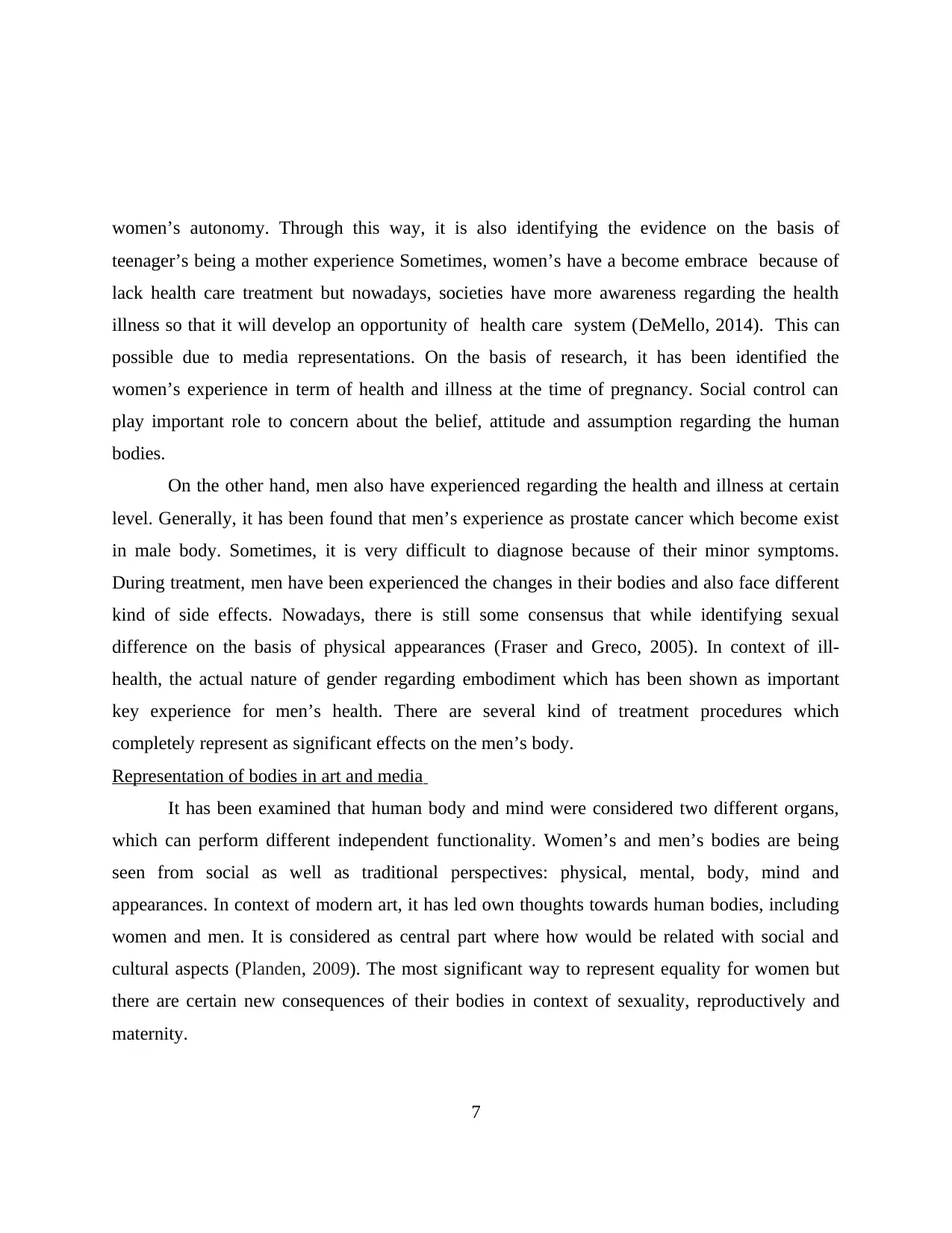
women’s autonomy. Through this way, it is also identifying the evidence on the basis of
teenager’s being a mother experience Sometimes, women’s have a become embrace because of
lack health care treatment but nowadays, societies have more awareness regarding the health
illness so that it will develop an opportunity of health care system (DeMello, 2014). This can
possible due to media representations. On the basis of research, it has been identified the
women’s experience in term of health and illness at the time of pregnancy. Social control can
play important role to concern about the belief, attitude and assumption regarding the human
bodies.
On the other hand, men also have experienced regarding the health and illness at certain
level. Generally, it has been found that men’s experience as prostate cancer which become exist
in male body. Sometimes, it is very difficult to diagnose because of their minor symptoms.
During treatment, men have been experienced the changes in their bodies and also face different
kind of side effects. Nowadays, there is still some consensus that while identifying sexual
difference on the basis of physical appearances (Fraser and Greco, 2005). In context of ill-
health, the actual nature of gender regarding embodiment which has been shown as important
key experience for men’s health. There are several kind of treatment procedures which
completely represent as significant effects on the men’s body.
Representation of bodies in art and media
It has been examined that human body and mind were considered two different organs,
which can perform different independent functionality. Women’s and men’s bodies are being
seen from social as well as traditional perspectives: physical, mental, body, mind and
appearances. In context of modern art, it has led own thoughts towards human bodies, including
women and men. It is considered as central part where how would be related with social and
cultural aspects (Planden, 2009). The most significant way to represent equality for women but
there are certain new consequences of their bodies in context of sexuality, reproductively and
maternity.
7
teenager’s being a mother experience Sometimes, women’s have a become embrace because of
lack health care treatment but nowadays, societies have more awareness regarding the health
illness so that it will develop an opportunity of health care system (DeMello, 2014). This can
possible due to media representations. On the basis of research, it has been identified the
women’s experience in term of health and illness at the time of pregnancy. Social control can
play important role to concern about the belief, attitude and assumption regarding the human
bodies.
On the other hand, men also have experienced regarding the health and illness at certain
level. Generally, it has been found that men’s experience as prostate cancer which become exist
in male body. Sometimes, it is very difficult to diagnose because of their minor symptoms.
During treatment, men have been experienced the changes in their bodies and also face different
kind of side effects. Nowadays, there is still some consensus that while identifying sexual
difference on the basis of physical appearances (Fraser and Greco, 2005). In context of ill-
health, the actual nature of gender regarding embodiment which has been shown as important
key experience for men’s health. There are several kind of treatment procedures which
completely represent as significant effects on the men’s body.
Representation of bodies in art and media
It has been examined that human body and mind were considered two different organs,
which can perform different independent functionality. Women’s and men’s bodies are being
seen from social as well as traditional perspectives: physical, mental, body, mind and
appearances. In context of modern art, it has led own thoughts towards human bodies, including
women and men. It is considered as central part where how would be related with social and
cultural aspects (Planden, 2009). The most significant way to represent equality for women but
there are certain new consequences of their bodies in context of sexuality, reproductively and
maternity.
7
Paraphrase This Document
Need a fresh take? Get an instant paraphrase of this document with our AI Paraphraser

From nowadays, an artist has been investigated the perceptions of human bodies and then
represent in the form of pictures. There are various artists presented in theoretical perspective,
insights of interpretive, human bodies as sign, function of aesthetic image. In order to represent
the actual presence of literature through art and media.
Art is the best way to represent the presence of any situation or condition. By using Art, Female
body and their enigmas: probes into the imaginary cultural of female body and examining the
better association with materiality of female body. This is the way to create or develop
assumptions by artist and then turn in the form of art such as painting.
On the other hand, the portrayal in media of men and women body image which has been
critical discussion occurs for some time. Media representations or image can represent as
unrealistic picture regarding body image of men and women. Sometimes, it is related to the super
slim and muscle bound men which gain most attention. In today’s world, many people can
understand the concept of body image manipulation in which possible (Shaylor and Meiners,
2013). As per evidence, it has been identified the clear pressure when look at young men and
women body image. Through media representations, it has been identified the tendency in both
gender towards concern about body weight, shape and height. Therefore, there has been
increased the level of depression which turns into high risk behaviours including substance
misuse. Moreover, it also emphasizes on the traditional or modern culture of celebrity in the
media. It is always encouraging the people to aspire or admire, also identify the unrealistic idea
of human bodies for both women, men. Media is a type of platform that will share a lot of
information about human bodies. It may be represented as positive as well as negative aspects.
This kind of situation is directly affecting the social culture and environment. It is very difficult
to manage and handle the complex situation.
Another way, media is also representing the positive perspective of female regarding the
body shapes, appearances. In order to measure as equal ability as compare with men’s.
8
represent in the form of pictures. There are various artists presented in theoretical perspective,
insights of interpretive, human bodies as sign, function of aesthetic image. In order to represent
the actual presence of literature through art and media.
Art is the best way to represent the presence of any situation or condition. By using Art, Female
body and their enigmas: probes into the imaginary cultural of female body and examining the
better association with materiality of female body. This is the way to create or develop
assumptions by artist and then turn in the form of art such as painting.
On the other hand, the portrayal in media of men and women body image which has been
critical discussion occurs for some time. Media representations or image can represent as
unrealistic picture regarding body image of men and women. Sometimes, it is related to the super
slim and muscle bound men which gain most attention. In today’s world, many people can
understand the concept of body image manipulation in which possible (Shaylor and Meiners,
2013). As per evidence, it has been identified the clear pressure when look at young men and
women body image. Through media representations, it has been identified the tendency in both
gender towards concern about body weight, shape and height. Therefore, there has been
increased the level of depression which turns into high risk behaviours including substance
misuse. Moreover, it also emphasizes on the traditional or modern culture of celebrity in the
media. It is always encouraging the people to aspire or admire, also identify the unrealistic idea
of human bodies for both women, men. Media is a type of platform that will share a lot of
information about human bodies. It may be represented as positive as well as negative aspects.
This kind of situation is directly affecting the social culture and environment. It is very difficult
to manage and handle the complex situation.
Another way, media is also representing the positive perspective of female regarding the
body shapes, appearances. In order to measure as equal ability as compare with men’s.
8
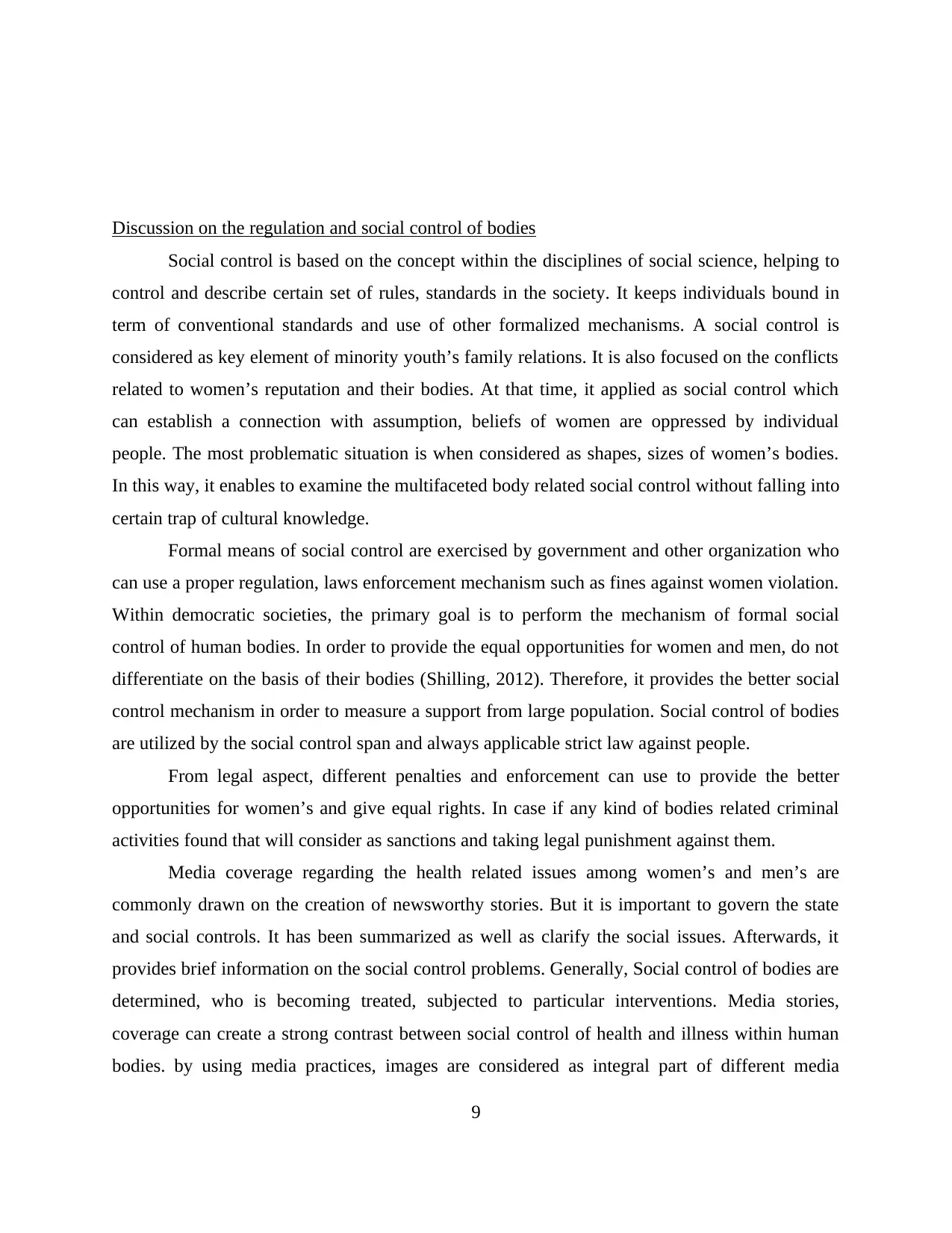
Discussion on the regulation and social control of bodies
Social control is based on the concept within the disciplines of social science, helping to
control and describe certain set of rules, standards in the society. It keeps individuals bound in
term of conventional standards and use of other formalized mechanisms. A social control is
considered as key element of minority youth’s family relations. It is also focused on the conflicts
related to women’s reputation and their bodies. At that time, it applied as social control which
can establish a connection with assumption, beliefs of women are oppressed by individual
people. The most problematic situation is when considered as shapes, sizes of women’s bodies.
In this way, it enables to examine the multifaceted body related social control without falling into
certain trap of cultural knowledge.
Formal means of social control are exercised by government and other organization who
can use a proper regulation, laws enforcement mechanism such as fines against women violation.
Within democratic societies, the primary goal is to perform the mechanism of formal social
control of human bodies. In order to provide the equal opportunities for women and men, do not
differentiate on the basis of their bodies (Shilling, 2012). Therefore, it provides the better social
control mechanism in order to measure a support from large population. Social control of bodies
are utilized by the social control span and always applicable strict law against people.
From legal aspect, different penalties and enforcement can use to provide the better
opportunities for women’s and give equal rights. In case if any kind of bodies related criminal
activities found that will consider as sanctions and taking legal punishment against them.
Media coverage regarding the health related issues among women’s and men’s are
commonly drawn on the creation of newsworthy stories. But it is important to govern the state
and social controls. It has been summarized as well as clarify the social issues. Afterwards, it
provides brief information on the social control problems. Generally, Social control of bodies are
determined, who is becoming treated, subjected to particular interventions. Media stories,
coverage can create a strong contrast between social control of health and illness within human
bodies. by using media practices, images are considered as integral part of different media
9
Social control is based on the concept within the disciplines of social science, helping to
control and describe certain set of rules, standards in the society. It keeps individuals bound in
term of conventional standards and use of other formalized mechanisms. A social control is
considered as key element of minority youth’s family relations. It is also focused on the conflicts
related to women’s reputation and their bodies. At that time, it applied as social control which
can establish a connection with assumption, beliefs of women are oppressed by individual
people. The most problematic situation is when considered as shapes, sizes of women’s bodies.
In this way, it enables to examine the multifaceted body related social control without falling into
certain trap of cultural knowledge.
Formal means of social control are exercised by government and other organization who
can use a proper regulation, laws enforcement mechanism such as fines against women violation.
Within democratic societies, the primary goal is to perform the mechanism of formal social
control of human bodies. In order to provide the equal opportunities for women and men, do not
differentiate on the basis of their bodies (Shilling, 2012). Therefore, it provides the better social
control mechanism in order to measure a support from large population. Social control of bodies
are utilized by the social control span and always applicable strict law against people.
From legal aspect, different penalties and enforcement can use to provide the better
opportunities for women’s and give equal rights. In case if any kind of bodies related criminal
activities found that will consider as sanctions and taking legal punishment against them.
Media coverage regarding the health related issues among women’s and men’s are
commonly drawn on the creation of newsworthy stories. But it is important to govern the state
and social controls. It has been summarized as well as clarify the social issues. Afterwards, it
provides brief information on the social control problems. Generally, Social control of bodies are
determined, who is becoming treated, subjected to particular interventions. Media stories,
coverage can create a strong contrast between social control of health and illness within human
bodies. by using media practices, images are considered as integral part of different media
9
⊘ This is a preview!⊘
Do you want full access?
Subscribe today to unlock all pages.

Trusted by 1+ million students worldwide
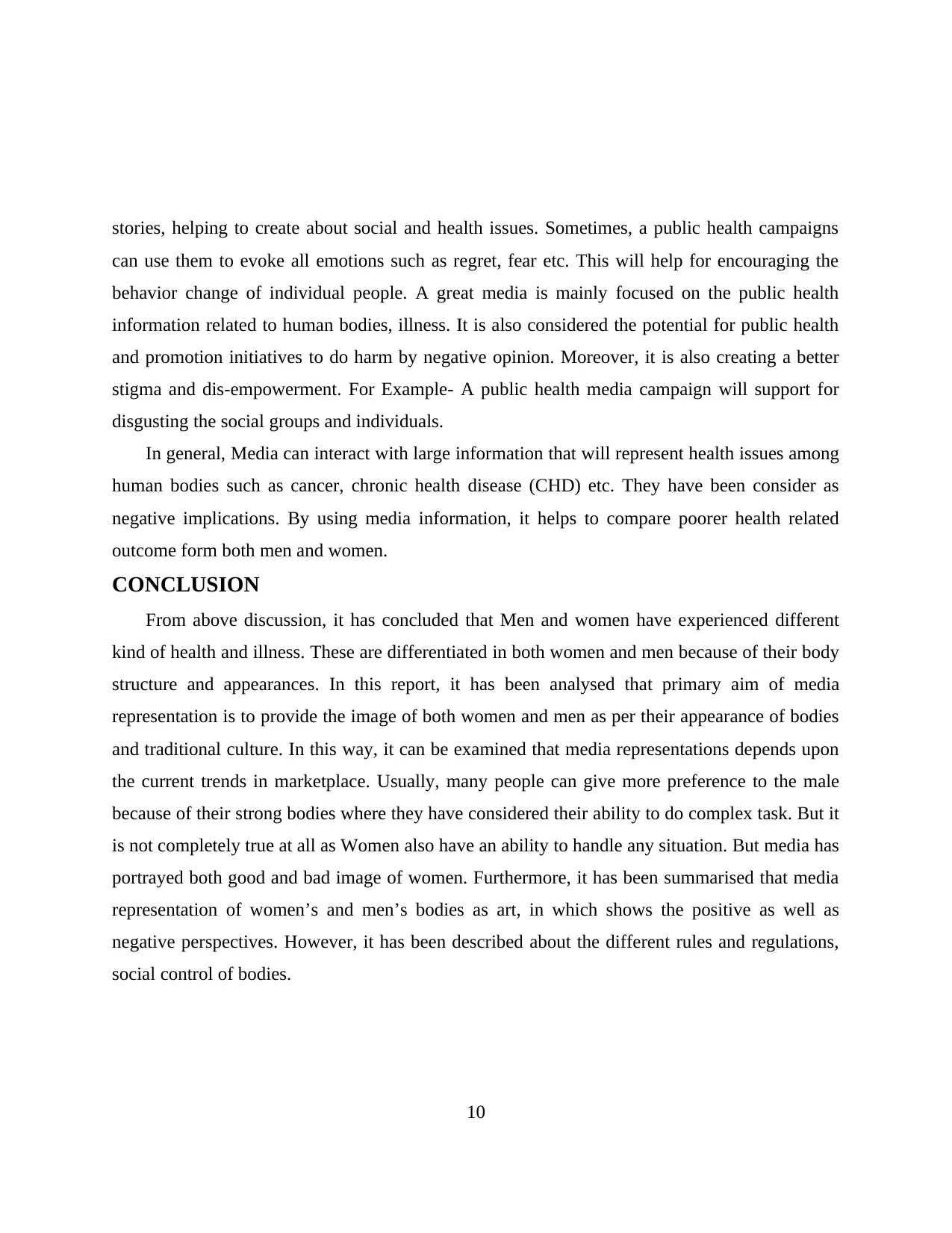
stories, helping to create about social and health issues. Sometimes, a public health campaigns
can use them to evoke all emotions such as regret, fear etc. This will help for encouraging the
behavior change of individual people. A great media is mainly focused on the public health
information related to human bodies, illness. It is also considered the potential for public health
and promotion initiatives to do harm by negative opinion. Moreover, it is also creating a better
stigma and dis-empowerment. For Example- A public health media campaign will support for
disgusting the social groups and individuals.
In general, Media can interact with large information that will represent health issues among
human bodies such as cancer, chronic health disease (CHD) etc. They have been consider as
negative implications. By using media information, it helps to compare poorer health related
outcome form both men and women.
CONCLUSION
From above discussion, it has concluded that Men and women have experienced different
kind of health and illness. These are differentiated in both women and men because of their body
structure and appearances. In this report, it has been analysed that primary aim of media
representation is to provide the image of both women and men as per their appearance of bodies
and traditional culture. In this way, it can be examined that media representations depends upon
the current trends in marketplace. Usually, many people can give more preference to the male
because of their strong bodies where they have considered their ability to do complex task. But it
is not completely true at all as Women also have an ability to handle any situation. But media has
portrayed both good and bad image of women. Furthermore, it has been summarised that media
representation of women’s and men’s bodies as art, in which shows the positive as well as
negative perspectives. However, it has been described about the different rules and regulations,
social control of bodies.
10
can use them to evoke all emotions such as regret, fear etc. This will help for encouraging the
behavior change of individual people. A great media is mainly focused on the public health
information related to human bodies, illness. It is also considered the potential for public health
and promotion initiatives to do harm by negative opinion. Moreover, it is also creating a better
stigma and dis-empowerment. For Example- A public health media campaign will support for
disgusting the social groups and individuals.
In general, Media can interact with large information that will represent health issues among
human bodies such as cancer, chronic health disease (CHD) etc. They have been consider as
negative implications. By using media information, it helps to compare poorer health related
outcome form both men and women.
CONCLUSION
From above discussion, it has concluded that Men and women have experienced different
kind of health and illness. These are differentiated in both women and men because of their body
structure and appearances. In this report, it has been analysed that primary aim of media
representation is to provide the image of both women and men as per their appearance of bodies
and traditional culture. In this way, it can be examined that media representations depends upon
the current trends in marketplace. Usually, many people can give more preference to the male
because of their strong bodies where they have considered their ability to do complex task. But it
is not completely true at all as Women also have an ability to handle any situation. But media has
portrayed both good and bad image of women. Furthermore, it has been summarised that media
representation of women’s and men’s bodies as art, in which shows the positive as well as
negative perspectives. However, it has been described about the different rules and regulations,
social control of bodies.
10
Paraphrase This Document
Need a fresh take? Get an instant paraphrase of this document with our AI Paraphraser
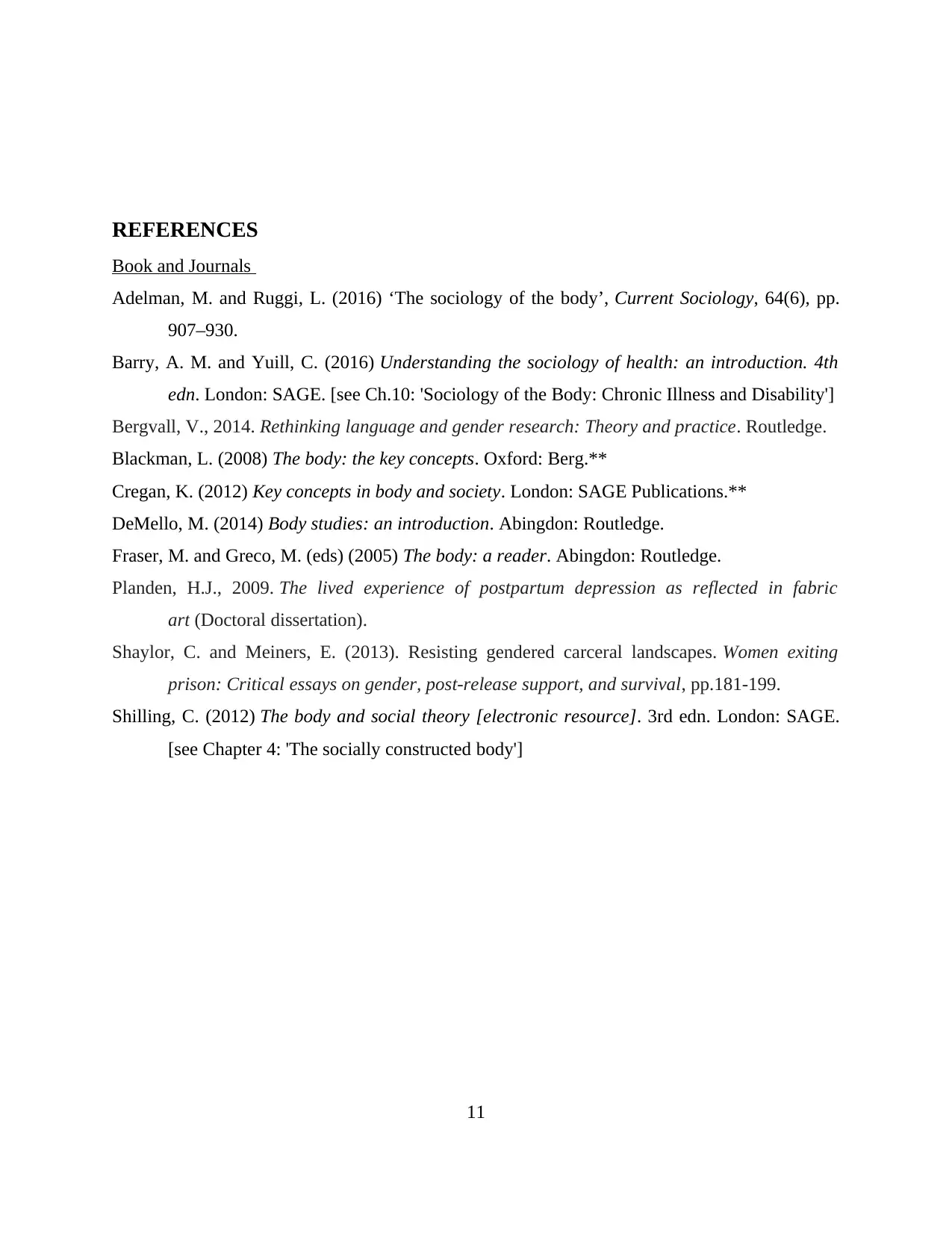
REFERENCES
Book and Journals
Adelman, M. and Ruggi, L. (2016) ‘The sociology of the body’, Current Sociology, 64(6), pp.
907–930.
Barry, A. M. and Yuill, C. (2016) Understanding the sociology of health: an introduction. 4th
edn. London: SAGE. [see Ch.10: 'Sociology of the Body: Chronic Illness and Disability']
Bergvall, V., 2014. Rethinking language and gender research: Theory and practice. Routledge.
Blackman, L. (2008) The body: the key concepts. Oxford: Berg.**
Cregan, K. (2012) Key concepts in body and society. London: SAGE Publications.**
DeMello, M. (2014) Body studies: an introduction. Abingdon: Routledge.
Fraser, M. and Greco, M. (eds) (2005) The body: a reader. Abingdon: Routledge.
Planden, H.J., 2009. The lived experience of postpartum depression as reflected in fabric
art (Doctoral dissertation).
Shaylor, C. and Meiners, E. (2013). Resisting gendered carceral landscapes. Women exiting
prison: Critical essays on gender, post-release support, and survival, pp.181-199.
Shilling, C. (2012) The body and social theory [electronic resource]. 3rd edn. London: SAGE.
[see Chapter 4: 'The socially constructed body']
11
Book and Journals
Adelman, M. and Ruggi, L. (2016) ‘The sociology of the body’, Current Sociology, 64(6), pp.
907–930.
Barry, A. M. and Yuill, C. (2016) Understanding the sociology of health: an introduction. 4th
edn. London: SAGE. [see Ch.10: 'Sociology of the Body: Chronic Illness and Disability']
Bergvall, V., 2014. Rethinking language and gender research: Theory and practice. Routledge.
Blackman, L. (2008) The body: the key concepts. Oxford: Berg.**
Cregan, K. (2012) Key concepts in body and society. London: SAGE Publications.**
DeMello, M. (2014) Body studies: an introduction. Abingdon: Routledge.
Fraser, M. and Greco, M. (eds) (2005) The body: a reader. Abingdon: Routledge.
Planden, H.J., 2009. The lived experience of postpartum depression as reflected in fabric
art (Doctoral dissertation).
Shaylor, C. and Meiners, E. (2013). Resisting gendered carceral landscapes. Women exiting
prison: Critical essays on gender, post-release support, and survival, pp.181-199.
Shilling, C. (2012) The body and social theory [electronic resource]. 3rd edn. London: SAGE.
[see Chapter 4: 'The socially constructed body']
11
1 out of 11
Related Documents
Your All-in-One AI-Powered Toolkit for Academic Success.
+13062052269
info@desklib.com
Available 24*7 on WhatsApp / Email
![[object Object]](/_next/static/media/star-bottom.7253800d.svg)
Unlock your academic potential
Copyright © 2020–2025 A2Z Services. All Rights Reserved. Developed and managed by ZUCOL.





